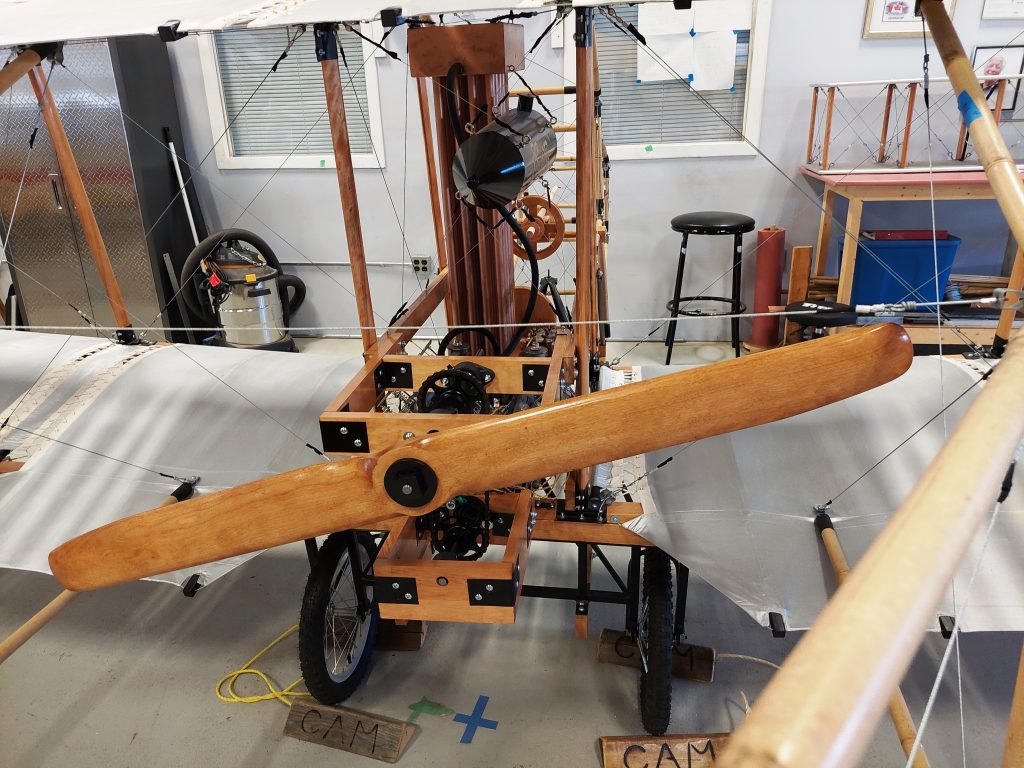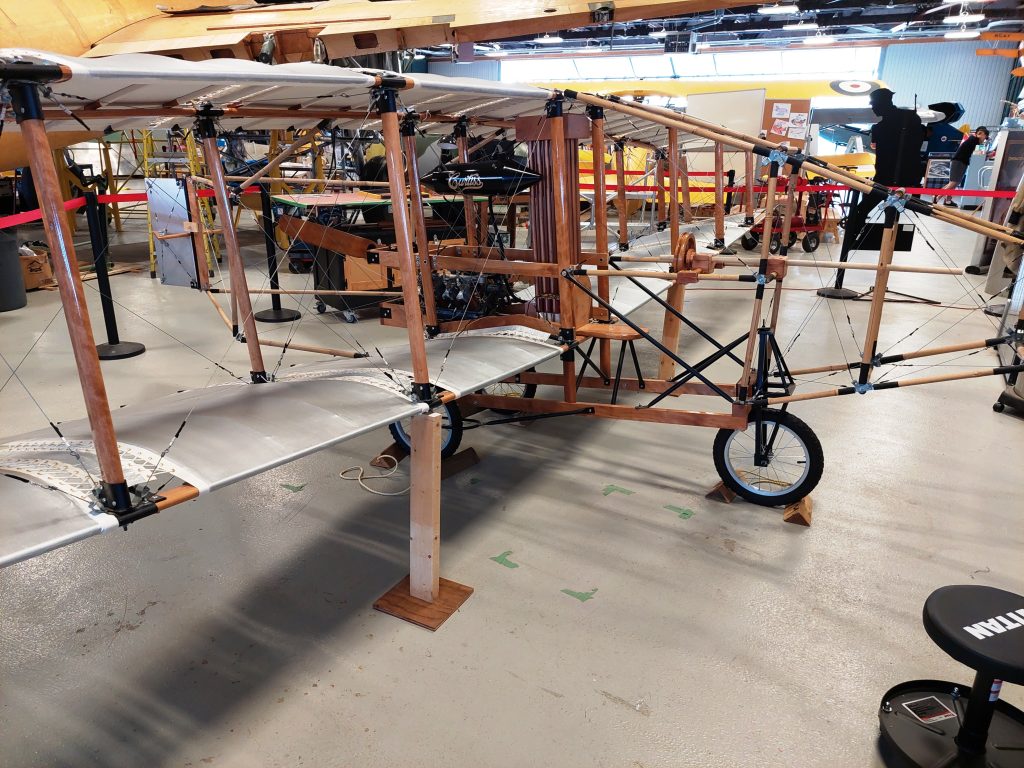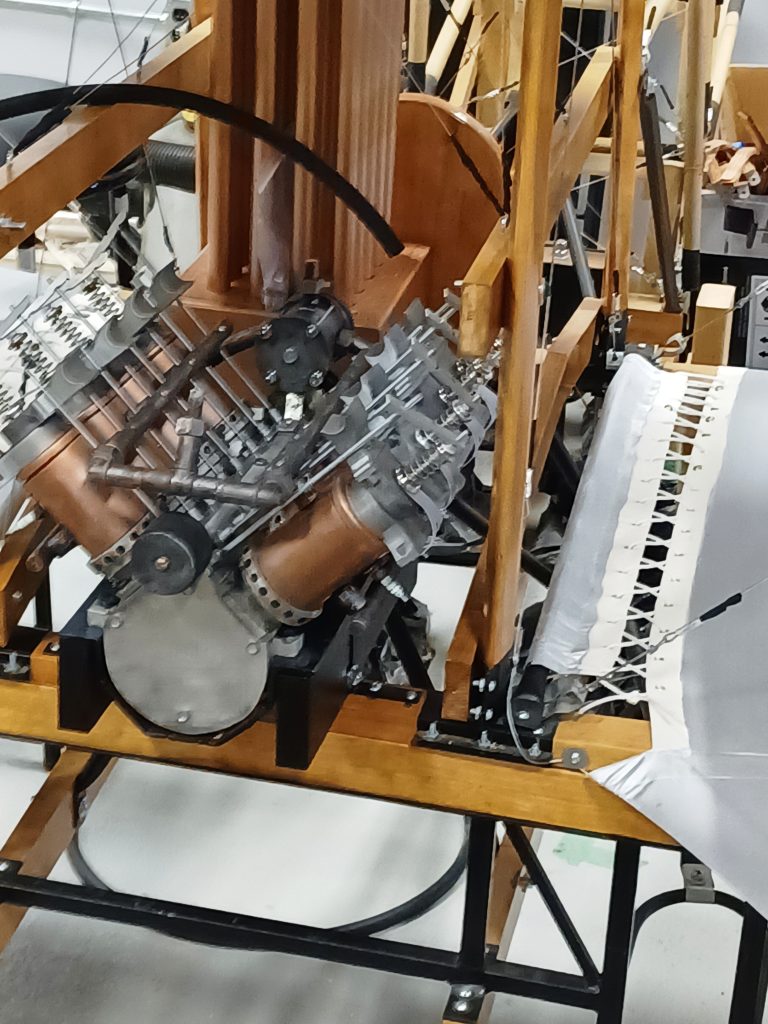AEA Silver Dart

Aircraft Details
- Wing Span………………15 m (49 ft)
- Length……………………12 m (39 ft)
- Height…………………….2.9 m (9 ft)
- Weight, Gross…………..390 kg (860 lb)
- Max Speed………………69 km/hr (43 mph)
- Rate of Climb……………Unknown
- Service Ceiling………….21.4 m (70ft)
- Range…………………….N/A
- Power Plant……………..single water-cooled, V8 motorcycle engine built by Glenn Curtiss
Aircraft Description
- First aircraft heavier than air to fly in Canada in 1909 – 5 years after Kitty Hawk flight
- Douglas McCurdy, a protégé of Alexander Graham Bell made the first flight at Baddeck Bay, Cape Breton on Tuesday afternoon, Feb 23, 1909
- With its tricycle undercarriage, the Silver Dart was able to become airborne under its own power
- One of the world’s first airplanes with ailerons to control roll
- Alexander Graham Bell and his wife Mabel convened and funded the Aerial Experiment Association, dedicated to develop aircraft
- Bamboo is used in the structure of the fuselage
Did you know that the Silver Dart was the inspiration for naming the RCAF’s first jet trainer, the CT-133 ‘Silver Star’?
The Why and How: Volunteer’s Story, Rob Douglas, Silver Dart Project Leader
To tell you the truth, I had no idea how much work would be involved in building our Silver Dart model. Had I known then what I know now, five years down the taxiway, I would have given it a lot more thought rather than just diving into the project. But we’re here now, getting close to finishing, and we have a beautiful airplane to appreciate.
I would have given more thought to the scale we chose, too. “Half scale, hmm, well, yeah, that seems about right.” At that size, our half size model equals the full size of many of the airworthy aircraft we have at the museum.
My association with CAM started with me spending Saturdays at the hangar acting as an “extra pair of hands” for my father, Ted Douglas. He was doing the meticulous wood work on the museum’s Mosquito. He made every one of the dozens of ribs in the wing and other parts that required a skilled woodworker. But he was getting on and certain things were becoming harder for him to do, so I was there to help when needed.
As the Mosquito project went along, the demand for fine woodwork was replaced by calls for other trades, and Dad was no longer needed. What to do to keep his skills sharp? And it occurred to us that the museum had a fine representative range of aircraft, from a Stearman biplane and a couple of Tiger Moths, through the Lancaster, to a T-33, but ironically, missing from the collection was the most significant aircraft in Canadian aviation history, the Silver Dart, the first airplane to fly in Canada (1909).
Problems solved! The Silver Dart was constructed of wood, bamboo, and wire. Building a model Silver Dart would draw on Dad’s skills, and would round out CAM’s collection of aircraft to include the very first plane to fly in Canada.
We proposed the building of a model of the Silver Dart in May of 2018. Soon afterwards it was accepted by the Board, and we’ve been at work on it steadily since then, apart from at least a year lost to the pandemic. Our group has designed and fabricated every single part of the plane by hand, with the exception of the three wheels. A “steam punk” enthusiast provided a marvellous replica of the engine and the Amherstburg Tinsmiths fabricated the gas tank. Researching, designing, fabricating and assembling the parts has been a labour of love. We’ve had a great deal of support from Doug Jermyn of the Welland Ontario group that built and flew their full size replica on the centennial of the first flight.
Our Silver Dart model now supports CAM’s educational programs, as an important part of the beginning of flight in Canada. It also highlights the talents of the dozen or so volunteer members of our group. Visitors are treated to the history of the Silver Dart, the details of aeronautical engineering pertinent to the 1900s, and the inputs to building a museum artifact from scratch.
The original Silver Dart was a product of Alexander Graham Bell’s Aerial Experiment Association (1907-09). While he and a group of younger associates did all the technical work, it was Bell’s wife Mabel, who was the steady, quiet inspiration of the project, conceiving the AEA and funding its activities. It’s amusing to our family that it was Ted’s wife Margaret who proposed the construction of a model Silver Dart, and who privately funded the project in full. If only Margaret and Mabel could have known one another. They would have had interesting conversations about creative husbands.
We’re nearly finished. Dad passed away a short time ago, but he did live long enough to see his dream built from nose to tail, with just a few details left to finish. I can tell you now we’ve never regretted taking on the building of the Dart. Sometimes it’s best just to open the throttle, pull back the stick a little, and see where things lead you.
Robert A Douglas
Silver Dart Project Leader
2023 07 27
AEA Silver Dart
Silver Dart, the first powered, heavier-than-air machine to fly in Canada; designed and built by the Aerial Experiment Assn (Oct 1907-Mar 1909) under Alexander Graham BELL, a flight enthusiast since boyhood. After several successful flights at Hammondsport, NY, early in 1909 the Silver Dart was dismantled, crated and brought to Baddeck Bay, NS, the Bells’ Canadian home. The “aerodrome” (Bell’s preferred term) had a 14.9 m wingspan and an all-up weight of 390 kg, pilot included.
J.A.D. MCCURDY was the principal designer and pilot; Glenn H. Curtiss developed the water-cooled engine, an advance on the association’s earlier experiments. Pulled on to the ice of Baddeck Bay by horse drawn sleigh on Feb 23, the silver-winged machine rose on its second attempt after travelling about 30 m, flying at an elevation from 3 to 9 m at roughly 65 km/hr for 0.8 km. Over 100 of Bell’s neighbours witnessed the first flight of a British subject anywhere in the Empire.
What you are looking At:
What you see here is a half-scale model of the real airplane. The model therefore has a wing span of 7.5 m (25 ft). All the parts were hand made here at the museum; only the wheels came off-the-shelf. The engine was crafted using ‘steam punk’ techniques.





